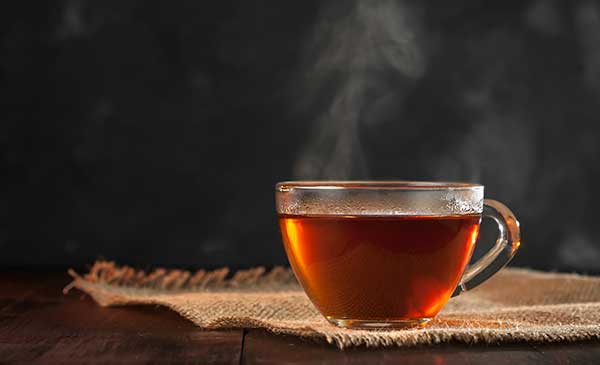What Does Black Tea Taste Like?

Black tea is popular but intimidating to some. Why? Because they don't know what black tea tastes like.
The flavor of this type of tea can range from smoky, spicy, or earthy to nutty, caramel, or fruity. It has a much bolder flavor than green tea or herbal tea. If you're switching from coffee, try black tea for its strong taste and high caffeine content.
But first, what is black tea?
True teas come from the Camellia Sinensis plant. This included black, green, and white tea. The variation lies in the process of oxidation.
Green and white teas are oxidized in a controlled way, resulting in a lighter color and flavor. Black tea is fully oxidized, which gives it a stronger taste. More oxidation also gives black tea a longer shelf life and retains flavor for several years. Black tea is also popular for iced tea.
Black tea originated in China in the mid-17th century. Before that period, people only drank green or oolong teas. The story is that an army chose to camp near a tea factory in the Fujian Province. Distracted by the presence of the army, the factory workers left the leaves in the sun for too long by mistake.
The leaves became fully oxidized, turning them dark. In an attempt to save the tea, the farmer finished drying them over an open pinewood fire. He discovered this added a smoky flavor to the tea. This tea is believed to be the first Lapsang Souchong that made black tea popular in China.
Black teas are named for where they are grown: Assam comes from India, Ceylon from Sri Lanka, and Darjeeling from India.
What DOES black tea taste like?
Black tea is the darkest of teas because it is the most oxidized tea. Oxidation is the process of exposing the tea leaves to air during the drying stage. Oxidation is responsible for the appearance of the tea as well as what the tea tastes like. Full oxidization turns the leaves dark and creates the flavor, strength, and aroma of the tea.
Black tea steeps out a dark reddish brew that has a strong, malty flavor. The aroma is deeper than other teas and the flavor is bolder. Black tea can be too bold for some which is why milk and sugar are often added.
Is black tea bitter?
Oxidation also gives the tea more tannins. Tannins during steeping are responsible for the flavor and caffeine level. Too few tannins and the tea can be described as weak, or dull. But too many tannins can make black tea bitter, so it is very important to steep the tea properly.
Flavors of black tea
There is more than one variety of black tea. As mentioned earlier, black teas are named for the country or region in which the tea plants were grown. For the best flavor, always start with loose-leaf tea instead of tea bags to experience the flavors to the fullest.

Assam tea
Grown in Assam, a region in northeastern India, this tea has a strong, malty flavor profile. Assam is one of the largest tea-producing regions in the world making Assam black tea very popular worldwide. Because of its higher caffeine content, it is typically what is used in breakfast blends.
Darjeeling black tea
From West Bengal, India comes Darjeeling, the champagne of teas. Darjeeling is a lighter, amber color and releases a delicate musky spiciness flavor and ripe fruit aroma.
There are two varieties of Darjeeling: First flush and Second flush. The first flush means they are the first leaves of the year. These leaves are often more flowery and lighter. A couple of months later comes the second flush producing leaves that are darker with a fruitier aroma.
Leaves picked later in the year (after the second growth) are not as good and are typically only sold in India.
Ceylon black tea
Ceylon tea is grown in Sri Lanka in one of three districts: Up-country, Mid-country, or Low-country. The altitude influences the grade as well as the taste of the tea. The high-elevation region of Sri Lanka provides the perfect climate for growing tea with warm days combined with ample rainfall.
Upcountry teas are lighter in color as well as flavor. Mid-country leaves are more full-bodied with a strong, rich aroma. Low-country leaves are still strong and rich, but typically the leaves are of lower quality.

Breakfast tea
Most breakfast teas are blends typically made from Assam, Ceylon, or Darjeeling. Breakfast teas have a stronger flavor with higher caffeine content, and are the perfect choice to start your day.
Breakfast teas produce a robust cup that goes well with a hearty morning meal. Because they are bolder blends, they often go well with a drop of milk.
English Breakfast tea is a classic breakfast tea. Made with Keemun black tea, it is a full-bodied blend with rich flavor and a slightly smoky palate. The astringency of this English tea is well-balanced with a honeyed aroma.
Keemun tea
Keemun is a black tea from China. The smooth flavor and delicately fruity and smoky notes are contrasted by the deep orange color. Keemun is more mellow with a floral and fruity sweetness but with less caffeine and maltiness than Assam tea.
Lapsang Souchong
Lapsang Souchong is a darker, amber brew. It has a smoky flavor that is the result of drying the leaves over a pinewood fire. The nutty, smoky flavor is delicious on its own and does not need the addition of milk.
Yunnan tea
One of the higher-end black teas is Yunnan black tea. It has a spicy, floral aroma with a reddish-black brew. It can have an earthy, honey-like sweetness with notes of tobacco, malt, or chocolate.
There are varying grades of Yunnan tea – the higher the quality, the less astringency. High-end Yunnan tea is sweet, while cheaper Yunnan tea is dark brown and can taste bitter.

Flavored black tea
Flavored black teas are very popular, particularly in the Western world. Typically built from a base of Assam or Ceylon, ingredients are added to create uniquely delicious blends.
Black tea is most often the base found in chai tea. Cinnamon, ginger, cardamom, orange, cloves, and apple are then mixed in to create a tasty blend like Cinnamon Apple Spice tea.
Masala Chai is made with strong black tea from Ceylon, mixed with fragrant spices like clove, cardamom, ginger, and cinnamon.
Black tea also blends well with fruit such as Ginger Peach tea with ginger root, peach, apricot flavor, and marigold flowers.
Earl Grey with vanilla and creme is a smoother version of the citrusy Earl Grey tea, making it easier to drink. Or blended with the sweet, floral fragrance of lavender creates a soothing, relaxing cup of Lavender Earl Grey tea.
Blended black teas are a good place to start if you are new to black tea. As you develop your palate you will appreciate the subtle nuances of each type of black tea.
What to put in black tea
If you like a sweeter cup, sugar can add extra depth to your cup. But be sure to use Belgian Rock sugar (or sugar rocks). Made from natural sugar beets, sugar rocks sweeten tea without affecting the flavor of the tea.
Black tea also handles a squeeze of citrus well - lemon or orange. It won't make your brew overly citrusy, it will just enhance the flavors of the tea, especially during warmer summer months.
Or try a black tea latte. Whip in some frothed milk to any of these teas for a creamy treat.
How to make black tea taste good
Being more oxidized, black tea can handle steeping at a higher temperature. But we recommend water just shy of boiling or 200 degrees. Using boiling water on black tea leaves can burn the leaf, and cause a bitter flavor.
Steeping the leaves too long can also cause bitterness, so be mindful of the time. Allow the leaves to steep for 2-3 minutes to release the color and aroma into your cup. A cup of brewed black tea will range from an amber orange to a very dark red color.
You can also steep black tea for a second cup. but the flavor will weaken with each steep. So use a longer steep time for each subsequent cup.





